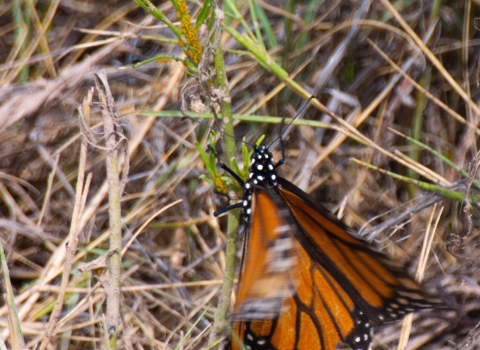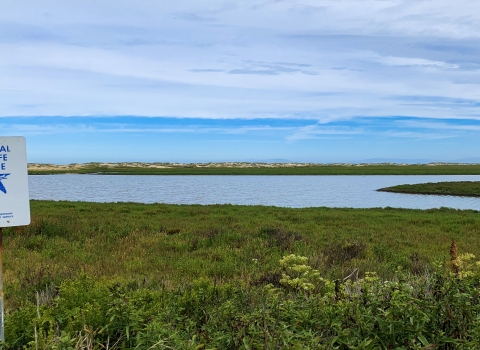What is a snail darter?
The snail darter is a small freshwater fish found in rivers and streams in Alabama, Georgia, Mississippi and Tennessee. Growing to just 2 ½ to 3 ½ inches long, the snail darter is named for its diet, which consists mostly of snails and insects.
What is the history of the snail darter under the Endangered Species Act?
The U.S. Fish and Wildlife Service listed the fish as endangered in 1975 due to the threat of a proposed impoundment for the Tennessee Valley Authority’s (TVA) Tellico Dam, near Lenoir City, Tennessee. At that time, it was the only known location of the fish. Conservationists sued to stop the dam from being completed because it would likely lead to the extinction of the snail darter. This was the first Endangered Species Act (ESA) case to reach the Supreme Court. In 1978, the court ruled in favor of protecting the snail darter.
In 1978, Congress amended the ESA to include the Endangered Species Committee process. The Committee, made up of Cabinet Secretaries, had the ability to review and exempt projects from the ESA in the case of a jeopardy finding. In January 1979, the committee declined to exempt the Tellico Dam project and uphold protections for the snail darter.
Congress then passed an amendment to a budget bill, exempting the Tellico Dam from ESA consultation requirements so that the dam could be completed. President Jimmy Carter signed the bill into law in 1979.
Meanwhile, snail darters were collected from the Little Tennessee River and transplanted to the Hiawassee and Holston rivers in Tennessee and then to other locations. Collaborative survey efforts with TVA and state partners also found the fish in several additional streams. The snail darter can now be found in Alabama, Georgia, Tennessee, and Mississippi.
In 1984, the snail darter was downlisted from endangered to threatened due to successful relocations and the discovery of new populations. Designated critical habitat was also rescinded at that time.
TVA has since implemented a Reservoir Release Improvement Program that has improved habitat and water quality below many TVA dams. This has benefitted snail darters and other aquatic species. TVA has further documented its commitment to the protection and conservation of fish, wildlife, and plants in 2021 by instituting a biodiveristy policy to proactively plan and manage for species and habitat within the Tennessee River system.
How does the Service determine if a species has recovered and no longer meets the definition of threatened or endangered under the ESA?
The Service periodically conducts reviews of the status of all listed species, as required by the ESA, and considers several factors in determining if a species has recovered. These factors include population size and distribution, the current and future status of the species, and known and potential threats. The Service conducted a thorough review of the snail darter and found that the snail darter has recovered based on all criteria measured. These include an increase in abundance and distribution and implementation of beneficial management practices across its range.
What conservation actions led to the recovery of the snail darter?
Snail darters were successfully translocated into the Hiwassee and Holston rivers starting in 1975. Other relocation and salvage efforts were attempted but did not result in established populations.
In 1991, TVA began implementing strategies to improve habitat and water quality conditions associated with their dams. These efforts benefitted the snail darter throughout its range. Watershed-level conservation efforts were implemented in the Paint Rock River, South Chickamauga Creek, and Sequatchie River watersheds by The Nature Conservancy, the Natural Resources Conservation Service, and local partnerships such as the Thrive Regional Partnership and the Limestone Valley Resource Conservation and Development Council. In tributary watersheds such as the Ocoee and Sequatchie where water quality was impacted by localized mining threats, conditions have improved due in part to the cessation of mining and efforts to clean up the mine sites. In watersheds with higher levels of agriculture and urbanization such as the South Chickamauga Creek and Paint Rock River watersheds, conservation programs were put in place to reduce the impact of these activities on the instream habitat used by the snail darter.
The Service will continue to work with multiple partners toward enhancing species viability. The snail darter also co-occurs with several other listed species, so its habitat will remain protected if the darter is delisted.
What is the process for delisting under the ESA?
To delist a plant or animal, the Service must first publish a proposed rule in the Federal Register explaining why the species no longer warrants protection under the ESA. We evaluated the species’ needs, current conditions, and future conditions in preparing a rule proposing to delist the snail darter. That rule published in September 2021. We sought and evaluated comments from independent specialists to ensure that our determination was based on scientifically sound data, assumptions, and analyses. We also invited peer reviewers to comment on the draft post-delisting monitoring plan. We considered all comments and information we received during the public comment period on the proposed delisting rule and the draft post-delisting monitoring plan when developing this final rule. We are now publishing a final rule delisting the snail darter. The delisting will take effect 30 days after its publication.
Will the snail darter continue to receive protections after delisting?
State water quality and wildlife laws will continue to protect the snail darter and its habitat. In addition, its range overlaps with other federally protected aquatic animals, so its habitat will not be affected.
Will the status of the snail darter continue to be monitored?
Yes. The ESA requires the Service to implement a system in cooperation with the states to effectively monitor the status of a species for a minimum of five years after delisting to ensure that it remains stable. The Service will coordinate with other federal agencies, state resource agencies, interested scientific organizations, and others as appropriate to develop and implement an effective post-delisting monitoring plan that will be published with this final rule delisting the species.


